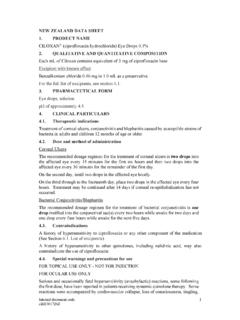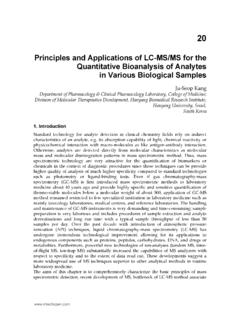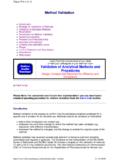Transcription of 2. QUALITATIVE AND QUANTITATIVE COMPOSITION
1 OliClinomel (Triple chambered parenteral nutrition bag) 1st complete range of 3 compartment bags containing ClinOleic 20% 1. NAME OF THE MEDICINAL PRODUCT OliClinomel N4-550E (1000 ml & 2000 ml) OliClinomel N7-1000E (1000 ml & 2000 ml) 2. QUALITATIVE AND QUANTITATIVE COMPOSITION The medicinal products are presented in the form of a 3-compartment bag. There are four presentations, which have the different volumes. Compartment 1000 ml 2000 ml Lipid emulsion 200 ml 400 ml Amino acid solution 400 ml 800 ml Glucose solution 400 ml 800 ml COMPOSITION of a 1000 ml bag (g) N4-550E N7-1000E Refined olive oil + refined soya oil* Alanine Arginine Glycine Histidine Isoleucine Leucine Lysine (As lysine hydrochloride) ( ) ( )
2 Methionine Phenylalanine Proline Serine Threonine Tryptophan Tyrosine Valine Sodium Acetate, 3H2O Sodium glycerophosphate, 5H2O Potassium chloride Magnesium chloride, 6H2O Anhydrous glucose (As glucose monohydrate) ( ) ( ) Calcium chloride, 2H2O * Mixture of refined olive oil (approximately 80%) and refined soya oil (approximately 20%) For the excipients, see After the contents of the three compartments have been mixed, the ternary mixture for each of the bag presentations provides the following: Per 1000 ml mixture N4-550E N7-1000E Nitrogen (g) Amino acids (g) 22 40 Total calories (kcal) 610 1200 Non-protein calories (kcal) 520 1040 Glucose calories (kcal) 320 640 Lipid calories (kcal) 200 400 Non-protein calorie/nitrogen ratio (kcal/g N) 144 158 Sodium (mmol) 21 32 Potassium (mmol) 16 24 Magnesium (mmol) Calcium (mmol) 2 2 Phosphate (mmol)** 10 Acetate (mmol) 30 57 Chloride (mmol) 33 48 pH 6 6 Osmolarity (mOsm/l) 750 1450 ** Phosphates provided by the lipid emulsion 3.
3 PHARMACEUTICAL FORM After reconstitution: emulsion for infusion. Appearance before reconstitution: The lipid emulsion is a homogenous liquid with a milky appearance, The amino acid and glucose solutions are clear and colourless or slightly yellow. Appearance after reconstitution: Homogenous liquid with a milky appearance. 4. CLINICAL PARTICULARS THERAPEUTIC INDICATIONS Parenteral nutrition for adults and children above two years of age when oral or enteral nutrition is impossible, insufficient or contraindicated. POSOLOGY AND METHOD OF ADMINISTRATION POSOLOGY The dosage depends on metabolic requirements, energy expenditure and the patient s clinical condition. The administration may be continued for as long as is required by the patient s clinical conditions. In adults Requirements Average nitrogen requirements are to g/kg/day (approximately 1 to 2 g of amino acids/kg/day). Maximum daily dose OliClinomel N4-550E: The maximum daily dose is 40ml/kg body weight (equivalent to g of amino-acids, g of glucose and g of lipids per kg), 2,800 ml of the emulsion for infusion for a patient weighing 70 kg.
4 OliClinomel N7-1000E: The maximum daily dose is 36 ml/kg body weight (equivalent to g of amino-acids, g of glucose and g of lipids per kg), 2,250 ml of the emulsion for infusion for a patient weighing 70 kg. In children above two years of age (In children above two years of age under non-exclusive parenteral nutrition) Requirements Average nitrogen requirements are to g/kg/day (approximately 2 to 3 g of amino acids/kg/day). Energy requirements vary depending on the patient's age, nutritional state and level of catabolism. On average these range between 60 and 110 kcal/kg/day. Posology The dosage is based on fluid intake and daily nitrogen requirements. These intakes should be adjusted to take account of the child's hydration status. Maximum daily dose OliClinomel N7-1000E: 75 ml/kg body weight (equivalent to 3 g amino-acids, 12 g of glucose and 3 g of lipids per kg body weight).
5 METHOD OF ADMINISTRATION For instructions for preparation and handling of the emulsion for infusion, see section Oliclinomel N4-550E BY INTRAVENOUS ADMINISTRATION THROUGH A CENTRAL OR PERIPHERAL VEIN Oliclinomel N7-1000E BY INTRAVENOUS ADMINISTRATION THROUGH A CENTRAL VEIN The recommended duration of the parenteral nutrition infusion is between 12 and 24 hours. The administration flow rate should be adjusted to take account of the dose being administered, the characteristics of the final mixture being infused, the daily volume intake and the duration of the infusion (see section ). Normally, the flow rate should be increased gradually during the first hour. Maximum infusion rate As a general rule, do not exceed: OliClinomel N4-550E: 3 ml/kg/hour of the emulsion for infusion, g of amino-acids, g of glucose and g of lipids per kg body weight per hour. OliClinomel N7-1000E: ml/kg/hour of the emulsion for infusion, g of amino-acids, g of glucose and g of lipids per kg body weight per hour.
6 Additions These products contain electrolytes. They contain neither trace elements nor vitamins. OliClinomel can be used as such or after supplementation with electrolytes, trace elements or vitamins, when required. (see sections and ). Electrolytes If electrolytes are added in OliClinomel over and above contained in OliClinomel with electrolytes, in no event should the following concentrations of electrolytes be exceeded per litre of the final mixture (see also section ). - Sodium: 150 mmol/l - Potassium: 150 mmol/l - Magnesium: mmol/l - Calcium: 5 mmol/l Trace elements and vitamins There are authorized formulae for adults, which are mutually exclusive. Paediatric formulations are required for children. CONTRAINDICATIONS Use of OLICLINOMEL is contraindicated in the following situations: - In premature neonates, infants and children less than 2 years old, as the calorienitrogen ratio and energy supply are inappropriate.
7 - Known hypersensitivity to egg or soya proteins or to any other ingredient. - Severe renal insufficiency without the possibility of haemofiltration or dialysis. - Severe hepatic insufficiency. - Congenital abnormalities of amino acid metabolism. - Severe blood coagulation disorders. - Severe hyperlipidaemia. - Hyperglycemia, which requires more than 6 units insulin/h. - For formulation with electrolytes: High and pathological plasma concentration of one of the electrolytes included in the product. The general contraindications for administrating an intravenous infusion are as follows: - Acute pulmonary oedema, hyperhydration, uncompensated cardiac insufficiency and hypotonic dehydration. - Unstable conditions (for example, following severe post-traumatic conditions, uncompensated diabetes mellitus, acute phase of circulatory shock, acute myocardial infarction, severe metabolic acidosis, severe sepsis and hyperosmolar coma).
8 SPECIAL WARNINGS AND SPECIAL PRECAUTIONS FOR USE Water and electrolyte equilibration disorders and metabolic disorders must be corrected before starting the infusion. The osmolarity of the final admixture after additions must be defined before administration. Caution should be exercised in administering OliClinomel to patients with increased osmolarity, adrenal insufficiency, heart failure or pulmonary dysfunction. Strict aseptic conditions must be observed when the catheter is inserted or handled all along infusion. Specific clinical monitoring is required when an intravenous infusion is started. Normally, the flow rate should be increased gradually during the first hour. This medicinal product contains Soya oil, which may rarely cause severe hypersensitivity reactions. The infusion must be stopped immediately if any abnormal signs or symptoms of an allergic reaction (such as fever, shivering, skin rashes or respiratory difficulties) develop.
9 When making additions, the final osmolarity of the mixture must be measured before administration. The mixture obtained should be administered through a central or peripheral venous line depending on its final osmolarity. If the final mixture which is administered is hypertonic, it may cause irritation of the vein when administered into a peripheral vein. Use only if the bag is not damaged, if the non-permanent seals are intact ( no mixture of the contents of the three compartments) and if the amino acids solution and the glucose solution are clear, and if the lipid emulsion is homogeneous. After opening the bag, the content must be used immediately and must never be stored for a subsequent infusion. Monitor water and electrolyte balance, serum osmolarity, acid/base balance, blood glucose and liver function tests throughout treatment. Serum triglycerides concentrations and the ability of the body to remove lipids must be checked regularly.
10 Serum triglycerides concentrations must not exceed 3 mmol/l during the infusion. These concentrations should not be determined before a minimum of a 3-hour period of continuous infusion daily by measuring serum triglycerides after a period of 5 to 6 hours without administering lipids. In adults, the serum must be clear in less than 6 hours after stopping the infusion containing the lipid emulsion. The next infusion should only be administered when the serum triglycerides concentrations have returned to normal values. In addition, regular clinical and laboratory tests are required particularly in cases of: - Amino acid metabolism disorders. - Hepatic insufficiency because of the risk of developing or worsening neurological disorders associated with hyperammonaemia (see section ). - Renal insufficiency, particularly if hyperkalaemia is present; risk of developing or worsening metabolic acidosis and hypernitrogenaemia if extra-renal waste removal is not being performed (see section ).






